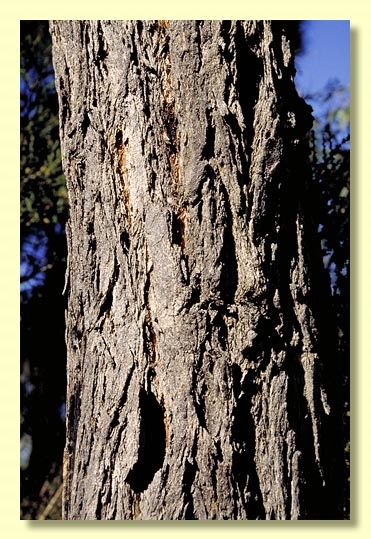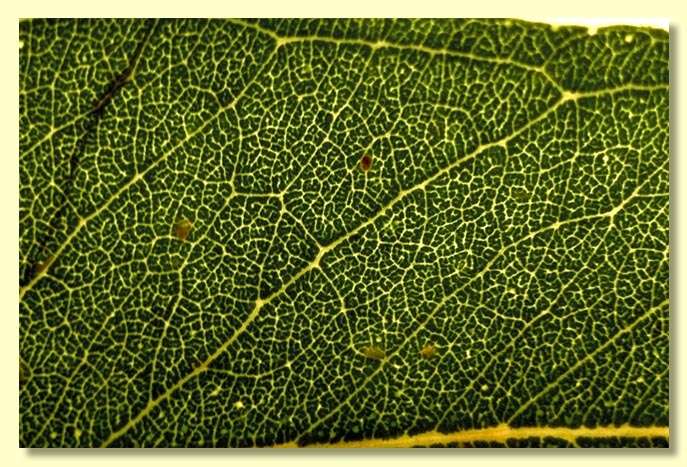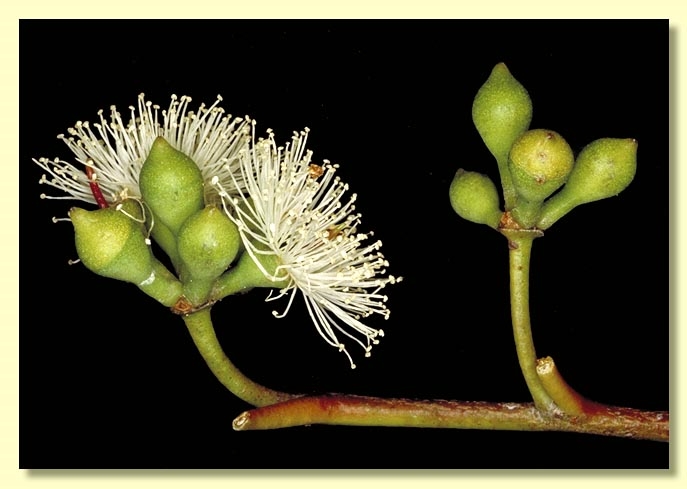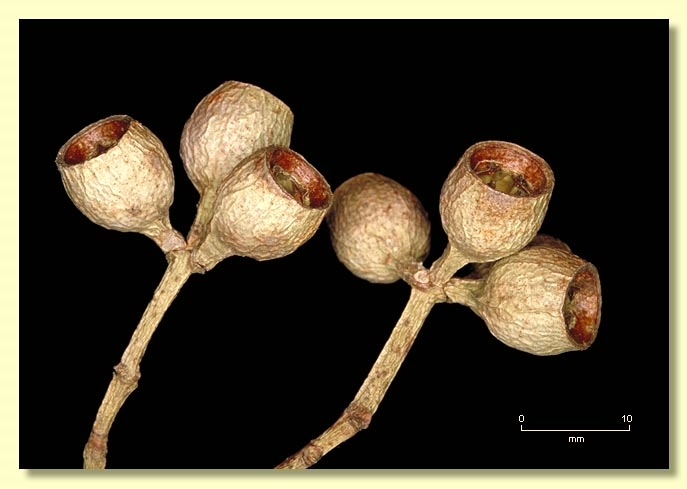Euclid - Online edition
Eucalyptus patens
Eucalyptus | Eucalyptus | Longistylus | Arboreae | Patentes
T: Harvey R., W.A., A.Oldfield; syn: K, MEL; Tone R., W.A., G.Maxwell s.n.; syn: K, MEL, NSW; Swan R., W.A., J.Drummond 4: 72; syn: BM, CGE, K, MEL, NSW, PERTH; south-western W.A., J.Gilbert s.n.; syn: BM; south-western W.A., J.S.Roe s.n.; syn: n.v.; Swan R. Colony, W.A., 1843, L.Preiss 252; syn: MEL.
Bark rough to small branches, stringy, crumbly, corky, fissured deeply longitudinally, grey-brown.
Branchlets lacking oil glands in the pith.
Juvenile growth (coppice or field seedlings to 50 cm): stems rounded in cross-section; juvenile leaves opposite, sessile and stem-clasping for up to ca 10 nodes then becoming petiolate, alternate, ovate, 8–20 cm long, 4.5–10.5 cm wide, discolorous, green, apex a drip-tip.
Adult leaves alternate, petiole 1.2–2.8 cm long; blade lanceolate to falcate, 8–17 cm long, 1.5–3 cm wide, base tapering to petiole or oblique, margin entire, apex acute, concolorous, usually dull, green, side-veins greater than 45° to midrib, reticulation moderate to dense, intramarginal vein close to margin, oil glands obscure or absent.
Inflorescence axillary unbranched, peduncles 0.5–2.2 cm long, buds 7, 9 or 11 per umbel, pedicels 0.3–0.7 cm long. Mature buds pyriform to obovate, 0.7–1.1 cm long, 0.5–0.7 cm wide, scar absent, the single operculum rounded and apiculate, stamens irregularly flexed or outer more or less erect and inner inflexed, anthers oblong to reniform, versatile, dorsifixed, dehiscing by longitudinal slits that are not confluent apically, style long and straight, stigma tapered, locules 4, the placentae each with 2 vertical rows of ovules. Flowers white.
Fruit on pedicels 0.1–0.7 cm long, truncate-globose to barrel-shaped, rarely narrowing below rim to form a neck, 0.7–1.4 cm long, 0.7–1.3 cm wide, disc descending, valves 4, enclosed.
Seeds similar in size, shape and colour to chaff particles, mid to dark brown, 1.5–3 mm long, D-shaped to more or less pyramidal, dorsal surface rounded, hilum terminal.
Cultivated seedlings (measured at ca node 10): cotyledons reniform; stems in cross-section, minutely scabrid variably below node 3 to 8; leaves sessile, opposite, elliptical and amplexicaul for ca 8 nodes, becoming shortly petiolate but remaining opposite until at least node 10, broadly ovate with rounded bases, 6.5–14 cm long, 4–7 cm wide, discolorous throughout, dull, dark green above.
Flowering has been recorded August, November, January and February.
A medium-sized to tall tree endemic to Western Australia. Eucalyptus patens is found from north-east of Perth on the Toodjay road, south and south-east to west of Albany on moist loamy sites in the valleys and sometimes on the lowlands, less often on low hills. The bark is rough and corky, distinguishing it from the far more common jarrah (E. marginata), which has its rough fibrous bark held in flattish strips. The adult leaves are dull, green and concolorous, while jarrah has discolorous leaves.
Eucalyptus patens belongs in Eucalyptus subgenus Eucalyptus section Patentes, distinguished by buds with a single operculum (hence no operculum scar), the operculum being rounded and apiculate, stamens more or less irregularly flexed, ovules arranged in two rows on the placenta, and the leaf and bark characters mentioned above. E. patens belongs to a small western sub-group of subgenus Eucalyptus that have oblong to reniform anthers shedding pollen through slits that remain separate, unlike western species E. marginata, E. jacksonii and E. staeri, and most eastern species in this subgenus, in which the anthers are characteristically reniform and shed through confluent slits.














